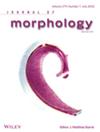Tatyana V. Kuzmina, Vladimir V. Malakhov
下载PDF
{"title":"腕足动物(腕足目,舌足目)的食道周围细胞","authors":"Tatyana V. Kuzmina, Vladimir V. Malakhov","doi":"10.1002/jmor.10904","DOIUrl":null,"url":null,"abstract":"<p>The celomic system of the articulate brachiopod <i>Hemithyris psittacea</i> is composed of the perivisceral cavity, the canal system of the lophophore, and the periesophageal celom. We study the microscopic anatomy and ultrastructure of the periesophageal celom using scanning and transmission electron microscopy. The periesophageal celom surrounds the esophagus, is isolated from the perivisceral cavity, and is divided by septa. The lining of the periesophageal celom includes two types of cells, epithelial cells and myoepithelial cells, both are monociliary. Some epithelial cells have long processes extending along the basal lamina, suggesting that these cells might function as podocytes. The myoepithelial cells have basal myofilaments and may be overlapped by the apical processes of the adjacent epithelial cells. The periesophageal celom forms protrusions that penetrate the extracellular matrix (ECM) of the body wall above the mouth and the ECM that surrounds the esophagus. The canals of the esophageal ECM form a complicated system. The celomic lining of the external circumferential canals consists of the epithelial cells and the podocyte-like cells. The deepest canals lack a lumen; they are filled with the muscle cells surrounded by basal lamina. These branched canals might perform dual functions. First, they increase the surface area and might therefore facilitate ultrafiltration through the podocyte-like cells. Second, the deepest canals form the thickened muscle wall of the esophagus and could be necessary for antiperistalsis of the gut. J. Morphol., 2011. © 2010 Wiley-Liss, Inc.</p>","PeriodicalId":16528,"journal":{"name":"Journal of Morphology","volume":"272 2","pages":"180-190"},"PeriodicalIF":1.5000,"publicationDate":"2010-12-01","publicationTypes":"Journal Article","fieldsOfStudy":null,"isOpenAccess":false,"openAccessPdf":"https://sci-hub-pdf.com/10.1002/jmor.10904","citationCount":"11","resultStr":"{\"title\":\"The periesophageal celom of the articulate brachiopod Hemithyris psittacea (Rhynchonelliformea, Brachiopoda)\",\"authors\":\"Tatyana V. Kuzmina, Vladimir V. Malakhov\",\"doi\":\"10.1002/jmor.10904\",\"DOIUrl\":null,\"url\":null,\"abstract\":\"<p>The celomic system of the articulate brachiopod <i>Hemithyris psittacea</i> is composed of the perivisceral cavity, the canal system of the lophophore, and the periesophageal celom. We study the microscopic anatomy and ultrastructure of the periesophageal celom using scanning and transmission electron microscopy. The periesophageal celom surrounds the esophagus, is isolated from the perivisceral cavity, and is divided by septa. The lining of the periesophageal celom includes two types of cells, epithelial cells and myoepithelial cells, both are monociliary. Some epithelial cells have long processes extending along the basal lamina, suggesting that these cells might function as podocytes. The myoepithelial cells have basal myofilaments and may be overlapped by the apical processes of the adjacent epithelial cells. The periesophageal celom forms protrusions that penetrate the extracellular matrix (ECM) of the body wall above the mouth and the ECM that surrounds the esophagus. The canals of the esophageal ECM form a complicated system. The celomic lining of the external circumferential canals consists of the epithelial cells and the podocyte-like cells. The deepest canals lack a lumen; they are filled with the muscle cells surrounded by basal lamina. These branched canals might perform dual functions. First, they increase the surface area and might therefore facilitate ultrafiltration through the podocyte-like cells. Second, the deepest canals form the thickened muscle wall of the esophagus and could be necessary for antiperistalsis of the gut. J. Morphol., 2011. © 2010 Wiley-Liss, Inc.</p>\",\"PeriodicalId\":16528,\"journal\":{\"name\":\"Journal of Morphology\",\"volume\":\"272 2\",\"pages\":\"180-190\"},\"PeriodicalIF\":1.5000,\"publicationDate\":\"2010-12-01\",\"publicationTypes\":\"Journal Article\",\"fieldsOfStudy\":null,\"isOpenAccess\":false,\"openAccessPdf\":\"https://sci-hub-pdf.com/10.1002/jmor.10904\",\"citationCount\":\"11\",\"resultStr\":null,\"platform\":\"Semanticscholar\",\"paperid\":null,\"PeriodicalName\":\"Journal of Morphology\",\"FirstCategoryId\":\"3\",\"ListUrlMain\":\"https://onlinelibrary.wiley.com/doi/10.1002/jmor.10904\",\"RegionNum\":4,\"RegionCategory\":\"医学\",\"ArticlePicture\":[],\"TitleCN\":null,\"AbstractTextCN\":null,\"PMCID\":null,\"EPubDate\":\"\",\"PubModel\":\"\",\"JCR\":\"Q2\",\"JCRName\":\"ANATOMY & MORPHOLOGY\",\"Score\":null,\"Total\":0}","platform":"Semanticscholar","paperid":null,"PeriodicalName":"Journal of Morphology","FirstCategoryId":"3","ListUrlMain":"https://onlinelibrary.wiley.com/doi/10.1002/jmor.10904","RegionNum":4,"RegionCategory":"医学","ArticlePicture":[],"TitleCN":null,"AbstractTextCN":null,"PMCID":null,"EPubDate":"","PubModel":"","JCR":"Q2","JCRName":"ANATOMY & MORPHOLOGY","Score":null,"Total":0}
引用次数: 11
引用
批量引用

 求助内容:
求助内容: 应助结果提醒方式:
应助结果提醒方式:


